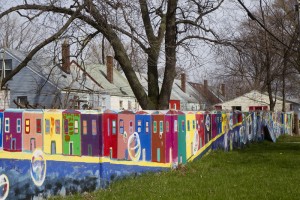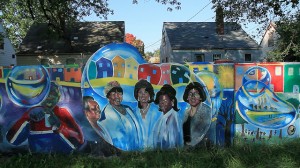Stepping outside the train station being greeted by vibrantly painted wooden furniture, on my left, two men were laid on chairs under an umbrella snoozing the peaceful Sunday away. On my right, another man was sitting on a bench in front of a acrylic painted piano. And then another, who was nowhere near the furniture, was guiding drivers inside motor vehicles where to park towards a parking deck. Walking across the street and then up the stairs hearing the bass of music playing, once I reached the top, I saw families taking pictures of the painted figurines that were scattered around the quad. Further back towards where the bass was coming from, there was band of musicians in colorful tribal clothing. The audience in front of them seemed to be enjoying their rhythmic tunes and they were clapping along to the beat of the music.
As I walked into the High Museum of Art, it was mostly crowded with families alike and authority. Once I received my admission, thankful that it was a free day and I didn’t have to spend nearly $17 for it, I followed the bodies that headed to where I assumed the artifacts would be. Walking through an open door, on my right there was a painted exterior of what looked as though inspired by a classic children’s book I haven’t read since my younger years. As I kept going straight, there was an area for families and their small children to sit at as one of the employees were engaging with them in a performance to teach the little ones things about art.
For it being my first time into the High Museum, I didn’t necessarily knew where to go or what to see other than from I constantly see from peers posting on social media such a Twitter. Tumblr, and Instagram. Once I saw people coming up and down from ramps and followed a couple of signs here and there, I went up the first ramp and walked into the European and Early American Art sections at the second level.
Also, because I don’t usually stumble upon art galleries or museums as much I would like to, I didn’t know if there was a certain way people were to look at art. I knew that everybody does it differently. I would believe that the galleries would be full of scholars observing and possibly discussing with one another what’s the interpretation of such pieces, but I reckon that’s a stereotype I was taught to believe. The first gallery that caught my eye was one that held pottery items. There was two young girls already in there, and once I begin to kill time waiting for my friend to arrive, they left the small gallery. So there I was, alone in a section of the museum. It wasn’t intimidating; however, I just didn’t want to be seem bored although the arts is something is something I’m greatly fond of. Besides, I’ve been wanting to attend this museum since I first heard of it. So as my anxious body slowly walks through a small gallery of porcelain values, I skimmed the details of them and read their descriptions as well. Once I was finishing my observation, a small Asian family came into the gallery. As I was existing, a small boy was whimpering with tears as the mother stooped down in eye level to seek what was wrong with her son.
As I waited for my friend to arrive, I walked through the European Art section. Some of the people I passed through were friends following each other, others were taking pictures of their friends in front of the art pieces, more families with young ones and mothers demanding their children not to run in the museum and then there was a young woman taking a selfie with one of the pieces as well. As I began to walk through the American Art section, there was a woman taking pictures of her two children in front of these life-sized portraits of Native American Indian chiefs and generals. Around the gallery, a couple security guards were patrolling the area. Walking further, I got nervous and intimidated wanting to take a picture of this vanity with a board on the center horizon of its mirror because of the people around me including this one security, who probably wouldn’t have cared because she must have seen thousands of young adults and teenagers done it before, but still I was immensely intimated.

Once my friend finally arrived, we skipped the third floor and went straight to the fourth floor where all the Contemporary, Folk and Modern Art was held. First, we went through the Folk Art section, and he had me stand in front of a colorful quilt taking my picture with his camera and he had me do the same for him. Apparently, he was standing so close to it that he actually touched it without knowing and a security guard was nice enough to request him to be careful about it. Then as we wandered on, we walked into this giant exhibit room showcasing Walter Evans’ photography. At one point, I saw a young man drawing the face of one of his photographs while passing through. Once we finished walking around that level of the museum, we decided to walk down a block or two up until we requested an Uber to ride back to campus.
Going to the High for the first time and seeing people just minding their own selves on a Sunday afternoon was a great experience. I believe it’s usually quieter on the weekdays so possibly if I ever do decide to go during then, I will be able to explore more, read more and feel more comfortable taking selfies on and with the artifacts and masterpieces. For a Sunday at the High, there was a lot of families around so I’m guessing that’s usually a special day for families to come and enjoy themselves and together. At one point, I saw a small group of students with their teacher talking about certain pieces. A variety of people come to the High, families, students, teachers, friends, artists and scholars. I think that’s something really amazing about art is that it brings people together in a way.

 Affordance: Something a design enable you to do.
Affordance: Something a design enable you to do.

















